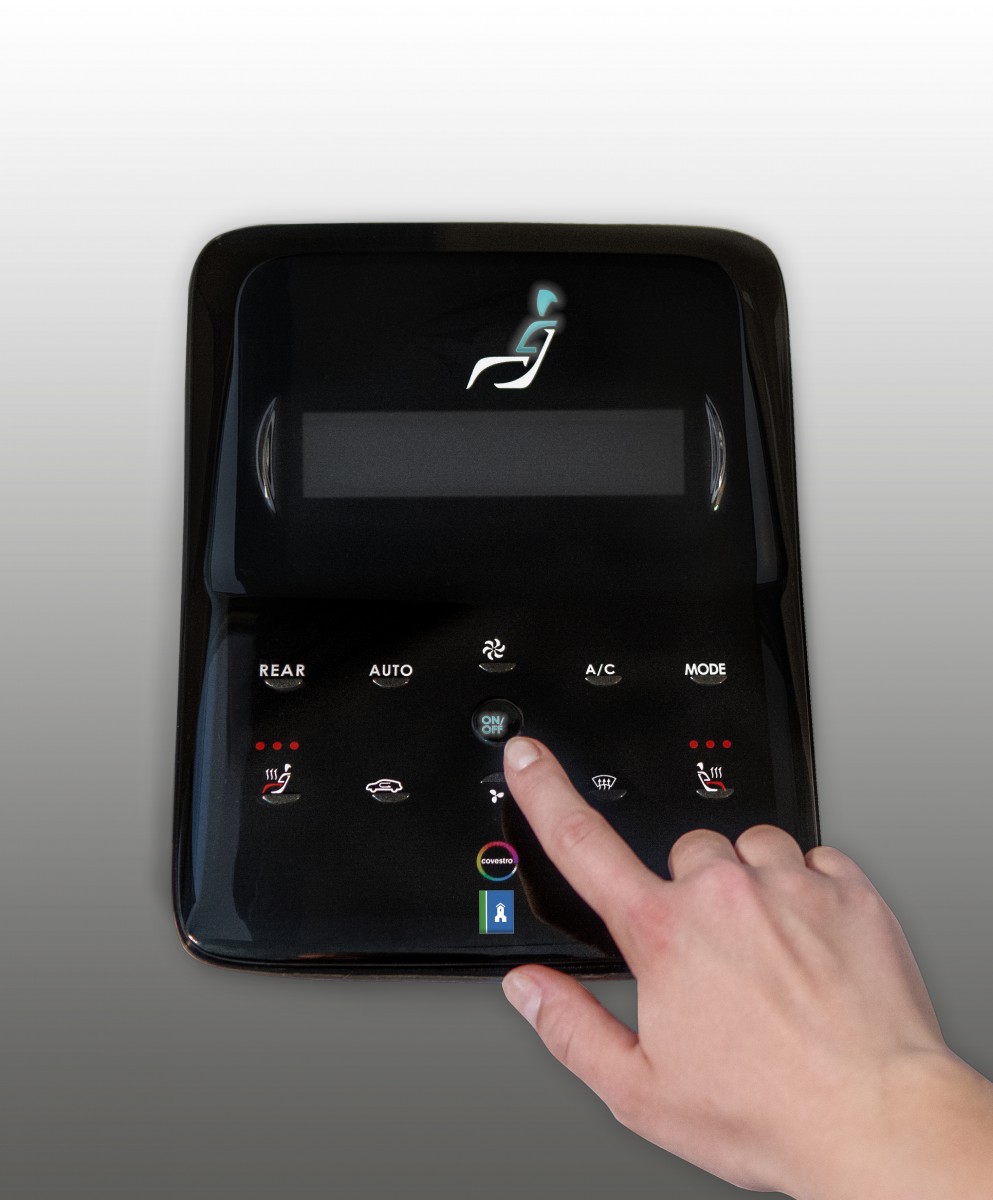More component performance and design freedom
Cooperation of Rühl Puromer and Covestro on DirectCoating
- Self-healing coating surfaces
- Good adhesion between polycarbonate and PU-RIM coating even during aging
- New methods for simulation of paint filling and component distortion
DirectCoating (DC) with polyurethane (PU) coating systems is a new process for producing functionally highly integrated and nobly decorated plastic parts economically and sustainably. Rühl Puromer GmbH and Covestro have joined forces to expand the technology's suitability for large-scale production.
"We want to open up the process for broad use in electromobility and autonomous driving applications and use it, for example, to manufacture large-area decorative parts with multifunctional, seamlessly integrated display, operating and ambient lighting elements for car interiors," explains Dr. Olaf Zöllner, head of application development Europe in Covestro's Engineering Plastics business entity.
"We also see good opportunities in highly integrated passenger car exterior parts such as spoilers, radar covers, front fascias and pillar trim with touch panels for vehicle access. There is also great potential in medical, communications and IT technology," adds Dr. Ingo Kleba, managing director at Rühl Puromer.
Almost unlimited design freedom
The DC process combines two established technologies in one process: injection molding of thermoplastics and reaction injection molding (RIM) of PU systems. First, a thermoplastic carrier is produced in a mold cavity and then transferred to a second cavity, which is enlarged by the thickness of the coating layer. There, the PU system is then injected onto the carrier.
The PU coatings offer unusually great freedom in design. The surface of the component can be made transparent, translucent or colored through, and it can be made highly resistant to chemical media such as fatty skin creams or given leather-like soft-touch haptics. Filigree surface structures can be precisely molded. High-gloss areas can be directly adjacent to matte structures. In addition, there is no need to invest in separate painting systems. Compared with spray painting, there is no paint loss due to overspray, and there is less scrap due to painting errors.
Scratches that disappear by themselves
Covestro has built up special PC and PC blend compounds under the Makrolon®, Bayblend® and Makroblend® brands for the DC process, as well as an extensive modular range of coating raw materials without solvent additives – such as special Desmodur® isocyanate crosslinkers and Desmophen® polyols – for PU coatings.
For the DC process, Rühl offers, among others, the light- and color-stable 2K PU coating systems puroclear®. Their RIM cycle times are usually at least equal to those of injection molding. The systems contain an "internal release function" that has been proven in series production many times. The mold therefore does not have to be sprayed with release agent. This contributes to short cycle times and a simple process.
In addition, self-healing variants have been added to the product range (reflow effect). Ingo Kleba: "Superficial scratches in the paint, which are quickly caused by vehicle keys or stone chips, for example, disappear by themselves over time. The components retain their appearance, value and function for longer, which means maximum suitability for everyday use."
Strong bond even after hydrolytic aging
Makrolon® and transparent puroclear® grades adhere firmly to each other in themselves. There was still room for improvement in terms of adhesion during aging. The development partners therefore optimized several material combinations and assessed their adhesive strengths in the POSI peel test (ISO 4624). "We can now offer material systems that meet OEM adhesion specifications even after prolonged aging in hot and humid environments," says Zöllner.
Flawless, air bubble-free surfaces
Precise simulation of the PU filling process and warpage are essential for optimal performance of a DC component. Covestro has developed suitable tools for this purpose. "With a new calculation method based on a two-phase CFD (computational fluid dynamics) simulation, it is now possible to precisely determine where air bubbles form during filling and whether they remain in the component or reach the mold vent. This was not possible with previous methods," explains Christoph Bontenackels, responsible for the calculation of DC components at Covestro. A new calculation tool is also available for simulating component distortion. It can be used to find the optimum layer thickness ratio for 3D structures with larger wall thickness jumps, at which warpage and cycle times are minimal.
Outlook – integration of films
The development partners want to expand the range of applications for the DC process even further. One approach is to integrate foils into the process in order to expand the possibilities for functional integration. For example, foils can be printed with conductive tracks and circuit diagrams on the reverse side, which is a prerequisite for equipping operating panels with backlit, inductive key functions.
About Covestro:
With 2020 sales of EUR 10.7 billion, Covestro is among the world’s leading polymer companies. Business activities are focused on the manufacture of high-tech polymer materials and the development of innovative, sustainable solutions for products used in many areas of daily life. In doing so, Covestro is fully committed to the circular economy. The main industries served are the automotive and transportation industries, construction, furniture and wood processing, as well as electrical, electronics, and household appliances industries. Other sectors include sports and leisure, cosmetics, health and the chemical industry itself. At the end of 2020, Covestro has 33 production sites worldwide and employs approximately 16,500 people (calculated as full-time equivalents).
Forward-looking statements
This news release may contain forward-looking statements based on current assumptions and forecasts made by Covestro AG. Various known and unknown risks, uncertainties and other factors could lead to material differences between the actual future results, financial situation, development or performance of the company and the estimates given here. These factors include those discussed in Covestro’s public reports which are available at www.covestro.com. The company assumes no liability whatsoever to update these forward-looking statements or to conform them to future events or developments.








